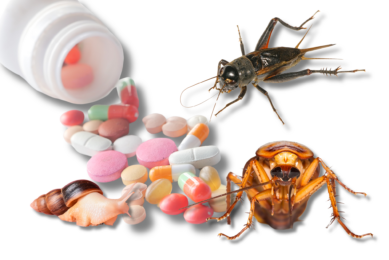Nutritional value of mealworm-based ingredients for cats and dogs

Increased consumer interest in high-quality and novel protein sources has driven the demand for the inclusion of protein-rich ingredients in companion animal diets. Novel protein sources such as insect-based ingredients are gaining ground in the pet food industry. In this new research, researchers evaluate the nutritional value of mealworm-based ingredients.
The world population is rising rapidly, creating pressure on mother earth; the greatest world challenge will be feeding every mouth with a safe, sustainable, and nutritious food source. The demand for animal-derived protein sources will continue to increase competition between the pet food industry and the human food system, requiring alternative protein sources. A body of research finds insects as an environmentally friendly alternative protein source in terms of high feed conversion efficiency, lower greenhouse gas emissions and reduced resources needed for large-scale production. Investigating how insects may serve as an alternative protein source now and in future is a sound idea for scientists and stakeholders with the same cause.
Although mealworm-based ingredients have been tested in livestock and aquaculture species, minimal research evaluating their use in companion animals exists. Testing amino acid (AA) and macronutrient composition and digestibility is imperative for ingredient evaluation in companion animal diets; knowing the digestibility and bioavailability of AA in feedstuffs is important to ensure that all AA requirements are met to achieve optimal performance.
Mealworm-based ingredients
Researchers at the University of Illinois evaluated the characteristics of mealworms as pet food ingredients. The scientists measured the nutrient composition, digestibility, and protein quality of four mealworm-based ingredients. The ingredients came from 2 different species of mealworms: Tenebrio molitor and Alphitobius diaperinus.
The 4 mealworm-based ingredients:
Whole lesser mealworm (Alphitobius diaperinus) meal
Defatted lesser mealworm (A. diaperinus) meal
Defatted yellow mealworm (Tenebrio molitor) meal
Hydrolysed yellow mealworm (T. molitor) protein meal
Nutrient composition
The nutrient composition results showed the highest values of organic matter and protein in the defatted lesser mealworm (A. diaperinus) (96.9% OM and 75.3% CP on DM basis) and lowest values in the whole lesser mealworm (Alphitobius diaperinus) (87.2% OM and 58.9% CP on DM basis); values from the T. molitor ingredients were intermediate. The highest concentrations of indispensable amino acids were observed in the hydrolysed yellow mealworm (T. molitor) protein meal with the lowest values recorded for the whole lesser mealworm ingredient (Table 1); all 10 indispensable AA measured in this study showed a similar trend.
Nutrient digestibility
Studies show that cats do not have high flow rates of digesta and there are difficulties in cannulating small animals. Therefore ileal cannulation in cats is not practical, whereas the cannulation procedure is no longer used in dogs due to animal welfare concerns. The cecectomised rooster assay is a good model for measuring the nutrient and AA digestibility of pet food ingredients. In previous studies, amino acid digestibility results of the cecectomised rooster assay and ileal-cannulated dogs were shown to be highly correlated. In this study, scientists used the precision-fed cecectomised rooster assay to test amino acid digestibility. The assay involves a surgical procedure, similar to a human appendectomy, that turns roosters into an effective, efficient model for dogs’ and cats’ digestive systems. The results (Table 2) showed that all 4 ingredients had high AA digestibilities, with all indispensable AA being >90% except for histidine (whole lesser mealworm – 88.8% and defatted yellow mealworm – 87.9%) and valine (whole lesser mealworm – 79.7%, defatted yellow mealworm – 77.9% and hydrolysed yellow mealworm protein – 79.5%).
Evaluating protein quality
Using the data from the faecal analysis, the scientists calculated digestible indispensable amino acid score (DIAAS)-like values. These calculations determine protein quality according to the Association of American Feed Control Officials (AAFCO) nutrient profiles, European Pet Food Industry Nutritional Guidelines (FEDIAF), and National Research Council (NRC) guidelines. These organisations offer recommended allowances for adult dogs, adult cats, growing puppies and growing kittens. Hydrolysed T. molitor protein meal had the highest DIAAS-like values, while defatted T. molitor meal had the lowest for most indispensable amino acids; however, all protein sources performed well.
Methionine and phenylalanine were the first limiting AA when references for adult dogs and growing kittens were used. The limiting AA were slightly different when references for growing puppies were used (methionine; threonine; histidine), but the results demonstrated that mealworm-based ingredients are high-quality protein sources. “Based on the DIAAS-like values generated in the current study, which assumes that diets would be formulated with only mealworm-based ingredients and would contain the recommended CP concentration, synthetic AA supplementation may be required to meet the requirements of all indispensable AA in diets of growing or adult dogs and cats,” said the scientists. “If used in combination with other protein sources, as is usually done in commercial pet foods, our results suggest that mealworm-based proteins may serve as a valuable protein source that may be used with a variety of complementary proteins.”
Conclusion
In conclusion, the current research demonstrated high amino acid digestibilities and DIAAS-like values for mealworm-based ingredients intended for use in dog and cat foods. There were no significant AA digestibility differences among the ingredients, with digestibilities of all indispensable AA being >90% except for histidine and valine.
“Collectively, our results demonstrate that mealworm-based ingredients are high-quality protein sources for pet foods,” the researchers wrote in the Journal of Animal Science. “Further research in dogs and cats is necessary to confirm sufficient palatability, digestibility, and product safety.”











